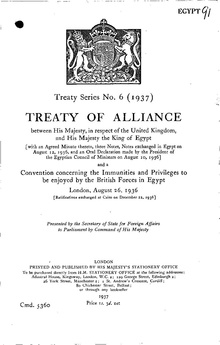Anglo-Egyptian treaty of 1936
[1] In November 1918, seven prominent Egyptians from the landed gentry and the legal profession, including Sa'd Zaghlul, formed a delegation, or wafd, whose chief goal was the complete independence of Egypt from British rule.
But when the wafd asked the British High Commissioner in Egypt if they could represent the country at the 1919 Paris Peace Conference, he refused.
As a result, the delegation organisers took their message of independence to the people of Egypt and this led to the founding of one of the most popular political parties in modern Egyptian history.
The result of these obstacles was a constant struggle for power between the British-backed King Fuad I, and the Wafd party that sought complete independence from the British.
[4][5] On 23 September 1945, after the end of World War II, the Egyptian government demanded the modification of the treaty to terminate the British military presence, and also to allow the annexation of the Anglo-Egyptian Sudan.
The nationalisation was technically in violation of the international agreement that Nasser had signed on 19 October 1954, although he agreed to pay compensation to the shareholders.
After international pressure and threats from the 2 new superpowers (the United States and the USSR), Britain, France and Israel were all forced to withdraw from Egypt, and the canal remained under Egyptian control.



